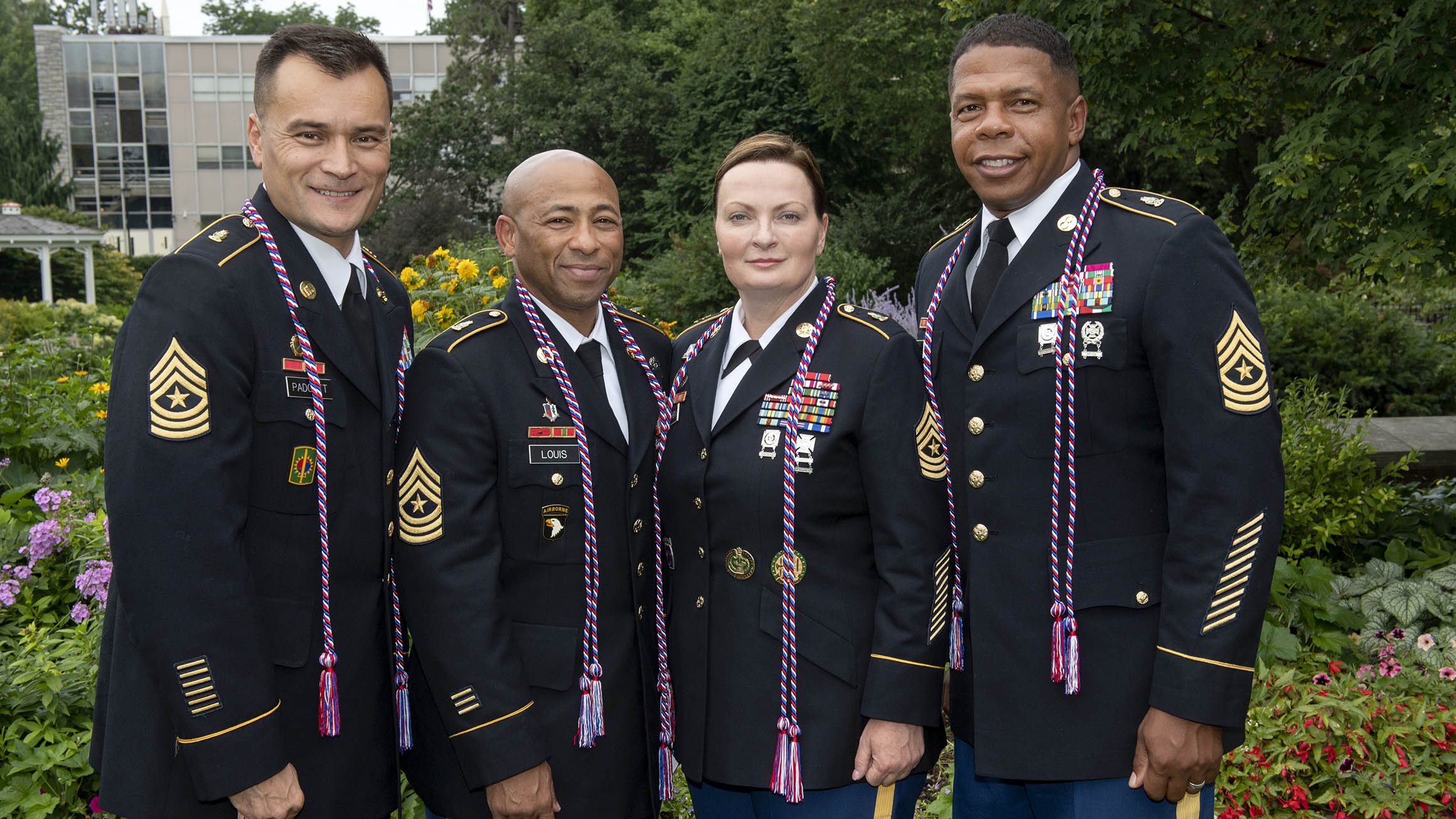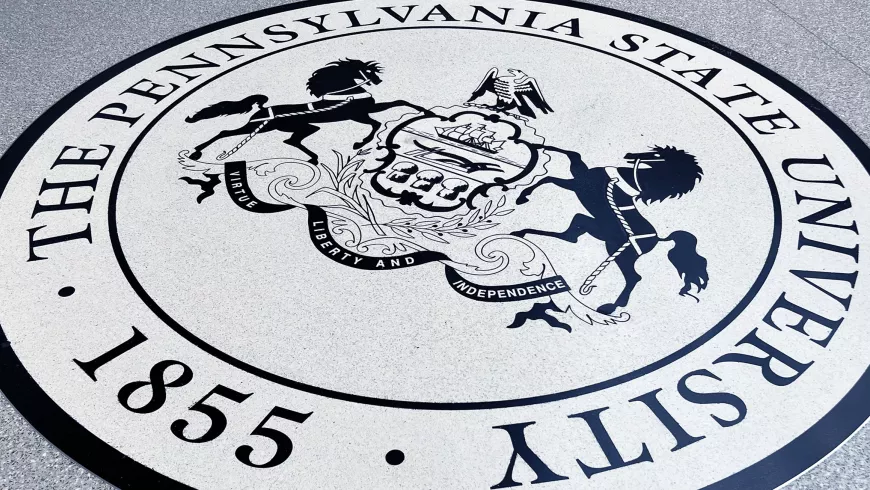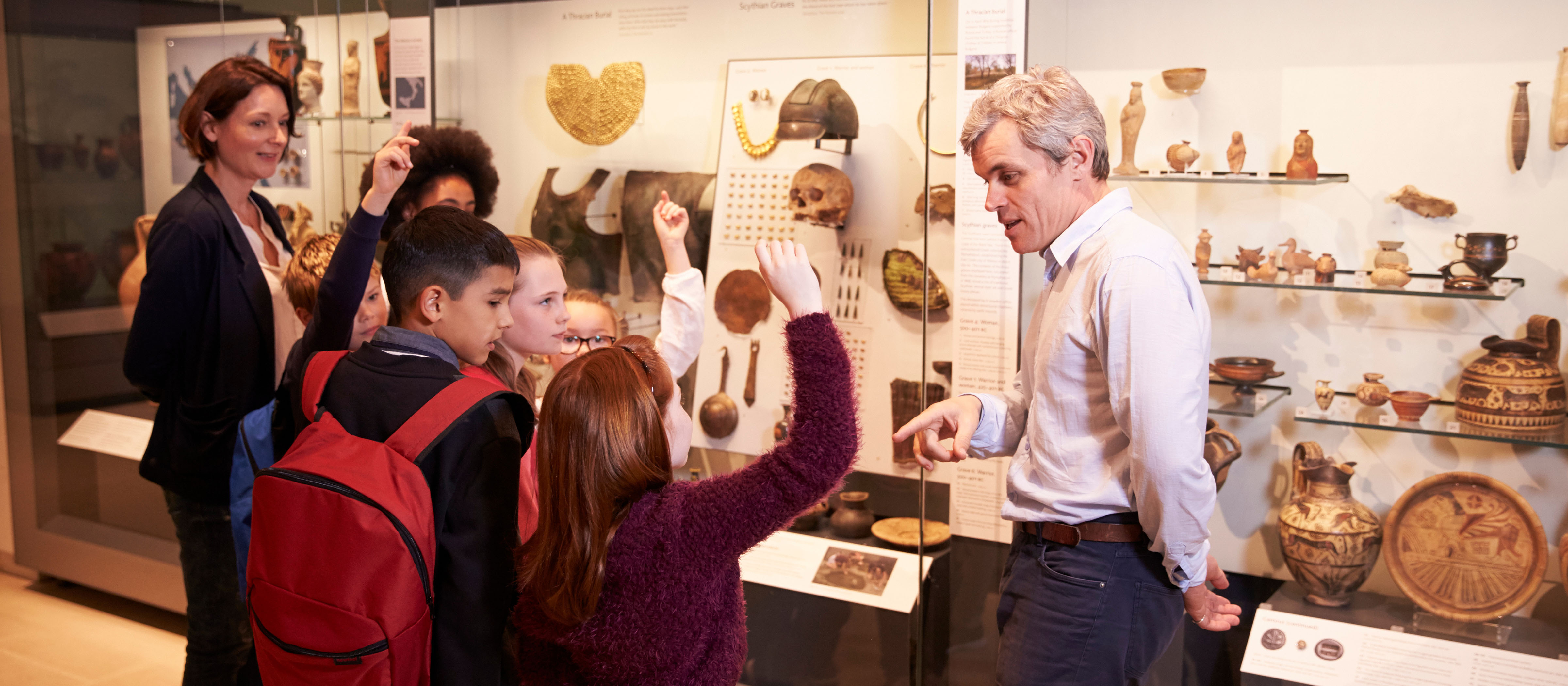100% Online
Complete your Penn State course work at your own pace and 100% online.
Application deadline
Credits and costs
Nationally Recognized

Gain Skills to Track Patterns throughout History
Examine the complex causality of past events, and use critical thinking to articulate the how and why of past events to move beyond monocausal explanations.
Create evidence-based historical arguments based on the evaluation and interpretation of both primary and secondary source materials, judging credibility, reconstructing historical context, and making inferences about genre, audience, perspective, and purpose.
Analyze the written work of others and collaborate with peers to analyze and understand historical contexts and content.
Employ digital technologies to solve writing, reading, and source-analysis problems, and present your work in a compelling and coherent fashion.
Fully Online History Courses
Fully Online History Courses
A Penn State history degree can help you understand history by gaining a deep knowledge of culture, religion, art, politics, and war. Students in this program can develop skills in writing, reading, primary and secondary source analysis, chronological reasoning, and understanding complex causality.
Courses
The Bachelor of Arts in History requires you to complete a minimum of 123 credits.
Prescribed Course (3 credits)
A student enrolled in this course must receive a grade of C or better.
- 3credits
Involves a thematic or topical investigation with an emphasis on historical criticism and analysis; students will pursue the study of one historical topic in detail in this writing intensive course.
- Prerequisite
4th semester standing
Additional Courses (6 credits)
A student enrolled in these courses must receive a grade of C or better.
- 3credits
An historical survey of the American experience from its colonial beginnings through the Civil War and Reconstruction.
- 3credits
An historical survey of the American experience from the emergence of urban-industrial society in the late nineteenth century to the present.
Supporting Courses and Related Areas (27 credits)
A student enrolled in these courses must receive a grade of C or better.
100–200 Level History Courses (12 credits)
Select 12 credits at the 100–200 level, one course from each of the following field categories:
- European History
- United States History
- Global History
- Pre-Modern History
Courses that appear in two categories (such as HIST 107) cannot be double-counted to be applied to two field categories. However, the student may choose to which category to apply the course.
European History (select 3 credits)
- 3credits
Covers the development of political, judicial, and diplomatic institutions; the role of religion as a significant element of medieval society; the development of royal houses; and changes in economic and social life of medieval Europe.
- 3credits
Political, social, and ideological developments; origin and impact of two World Wars; totalitarianism and democracy; changing role in the world.
- 3credits
In-depth study of the origins and conduct of World War II. Political and economic aspects as well as military.
United States History (select 3 credits)
- 3credits
Explores changing relationships between humans and the natural world, while examining American landscape, environmental activism, and the development of ideas about nature. Major themes include the natural context of American history and the socially constructed and historically contingent knowledge about nature.
- 3credits
Analyzes the history of agriculture and food production in the U.S., examining consumption patterns, the food industry, marketing, and regulation. Also explores the impact of food systems on human well-being and addresses issues of sustainability, productivity, social effects, and environmental impacts.
- 3credits
Focuses on key historical developments in women’s history, including actual experiences as members of a class, a race, and an ethnic community; the progress women have made as individuals, workers, and citizens; as well as the opposition they have faced.
- 3credits
Survey of the causes and consequences of America's deadliest conflict, the Civil War, from the end of the U.S.-Mexican War in 1848 through the end of Reconstruction in 1877.
Global History (select 3 credits)
- 3credits
Surveys the history of science and scientific inquiry on a global scale from the Neolithic period to the 19th century.
- 3credits
Introduces students to the history and culture of the Islamic world; develops a historical framework for understanding developments in religious and legal thought and practice, science, medicine, and technology, philosophy, and the arts.
- 3credits
Examines the history of modern Latin America, including the geographic and political development of the region, the development of various economic models, and the widespread extraction of labor focusing on African slavery and Indigenous exploitation.
- 3credits
Origins of Islamic civilization; expansion of Islam; the Ottoman Empire; the Middle East since 1918.
- 3credits
Looks at the origins, nature, and consequences of World War II in the Pacific; assesses different nations, political movements, ideologies, and empires that clashed across Asia-Pacific from 1931 to 1945.
- 3credits
Surveys modern Iranian history from the 19th century to the present day, analyzing significant events, policies, and revolutions in local, regional, and global contexts. Students learn key concepts, make comparisons, and understand the broader historical trends of the 20th century.
- or:3credits
Surveys modern Iranian history from the 19th century to the present day, analyzing significant events, policies, and revolutions in local, regional, and global contexts. Students learn key concepts, make comparisons, and understand the broader historical trends of the 20th century.
Pre-Modern History (select 3 credits)
- 3credits
Surveys the history of science and scientific inquiry on a global scale from the Neolithic period to the 19th century.
- 3credits
History of the Roman Republic and Empire from the origins of Rome to the disintegration of the Empire.
- 3credits
Covers the development of political, judicial, and diplomatic institutions; the role of religion as a significant element of medieval society; the development of royal houses; and changes in economic and social life of medieval Europe.
- 3credits
Introduces students to the history and culture of the Islamic world; develops a historical framework for understanding developments in religious and legal thought and practice, science, medicine, and technology, philosophy, and the arts.
Additional History Courses (select 3 credits)
Select an additional 100–400 level history course from any other category or
- 3credits
Examines the ideas that have shaped European and American perceptions of madness, insanity, and mental illness; the changing experiences of those afflicted; the development of those professions designed to look after those deemed mad, insane, and mentally ill; and the social and cultural assumptions behind treatments, policies, and public opinions.
400-Level History Courses (select 12 credits)
At least one 400-level course should be in Global History.
- 3credits
In-depth study of the history of the Holocaust in Europe that puts special emphasis on primary sources.
- 3credits
Explores the forces in Great Britain and America that caused withdrawal of thirteen colonies from the British Empire and the Revolutionary War.
- Prerequisite
HIST 020, 3 additional credits in history
- 3credits
Contemporary economic, social, and political aspects of the United States and its role as a world power since 1945.
- 3credits
Provides an understanding of the Constitutional developments from laissez-faire to the welfare state; imperialism, war, internationalism; the contemporary court, civil liberties, and civil rights.
- Prerequisite
Prerequisites: HIST 020 or HIST 021, plus 3 additional credits in history or political science.
- 3credits
The history of the ways Americans have used and thought about the environment since 1500.
- 3credits
A study of selected problems in the history of work in the United States, especially since 1877.
- 3credits
Focuses on the political, economic, and social changes in Turkey, Iran, Israel, and the Arab countries in the twentieth century; explores the Arab-Israeli conflict.
- Note
This course will fulfill the Global History requirement at the 400 level.
- 3credits
Theories and types of imperialism; varied patterns of colonial administration; initial African responses; nationalism; decolonization and independence.
- Note
This course will fulfill the Global History requirement at the 400 level.
- 3credits
Explores the complex social and cultural history of modern China from 1900 to the present, including the formation of the modern nation-state, the development of communism, and the relationship between elite and popular culture.
- Note
This course will fulfill the Global History requirement at the 400 level.
General Education Requirements
Some General Education requirements may be satisfied by courses required for the major. Students should work with an adviser to select courses.
- Foundations: 15 credits
All courses require a grade of C or better. Inter-Domain courses may not be used for foundations requirements.- Writing/Speaking: 9 credits
- Quantification: 6 credits
3-6 credits are selected from mathematics, applied mathematics, and statistics; 3 credits may be selected from computer science or symbolic logic.
- Knowledge Domains: 15 credits
Inter-Domain courses may not be used for knowledge domain requirements.- Health and Wellness (GHW): 3 credits
- Natural Sciences (GN): 3 credits
- Arts (GA): 3 credits
- Humanities (GH): 3 credits
- Social and Behavioral Sciences (GS): 3 credits
- Integrative Studies: 6 credits
- Inter-Domain course work: 6 credits
- Exploration: 9 credits
- Natural Sciences (GN) (may be Inter-Domain): 3 credits
- GA, GH, GN, GS, and Inter-Domain courses: 6 credits
May include 3 credits of World Language course work beyond the requirements of the student’s degree program or at the 12th credit level, whichever is higher.
These General Education Requirements are for students who started in summer 2023 or later. Students who started earlier can review the prior version of the general education requirements.
Bachelor of Arts Degree Requirements
Some Bachelor of Arts requirements may be satisfied by courses required for the major, General Education courses, or electives. Students should work with an adviser to select courses.
- Foreign Language: 0–12 credits
Students must attain 12th credit level of proficiency in one foreign language. - B.A. Fields: 9 credits
Humanities, Social and Behavioral Sciences, Arts, Foreign Languages, Natural Sciences, Quantification (cannot be taken in the area of the student's primary major; foreign language credits in this category must be in a second foreign language or beyond the 12th credit level of proficiency in the first language) - Other Cultures: 0–3 credits
Select 3 credits from approved list. Students may count courses in this category in order to meet other major, minor, elective, or General Education requirements, except for the General Education US/IL requirement.
Course Availability
If you're ready to see when your courses will be offered, visit our public LionPATH course search (opens in new window) to start planning ahead.
Start or Advance Your Career

Start or Advance Your Career
You can use the knowledge gained from this online history degree program and the support of Penn State career resources to pursue careers in a variety of fields, depending on your goals.
Job Titles Related to This Degree
History major graduates can explore various career paths or graduate degrees depending on their aspirations and course work. Common careers pursued by graduates from this program include:
- County Historian
- Historic Sites Registrar
- Museum Educator
- Research Associate
Employment Outlook for Occupational Fields Related to This Degree
Estimates of employment growth and total employment are provided by the U.S. Bureau of Labor Statistics and are subject to change. While these occupations are often pursued by graduates with this degree, individual outcomes may vary depending on a variety of factors. Penn State World Campus cannot guarantee employment in a given occupation.
Tour and Travel Guides
Historians
Additional Job Fields and Opportunities
Graduates can also consider exploring careers in:
- Education — primary and secondary teaching, higher education
- Business — management, sales, human resources, public relations
- Media — editing, reporting, news
- Law — public and private defense, prosecution, government
- Local and state government — city or town management, community services, law enforcement
Career Services to Set You Up for Success

From the day you're accepted as a student, you can access resources and tools provided by Penn State World Campus Career Services to further your career. These resources are beneficial whether you're searching for a job or advancing in an established career.
- Opportunities to connect with employers
- Career counselor/coach support
- Occupation and salary information
- Internships
- Graduate school resources
Upcoming Events
Ready to Learn More?
Get the resources you need to make informed decisions about your education. Request information on this program and other programs of interest by completing this form.
Ready to take the next step toward your Penn State bachelor's degree?
Costs and Financial Aid
Costs and Financial Aid
Learn about this program's tuition, fees, scholarship opportunities, grants, payment options, and military benefits.
Costs and Financial Aid
Undergraduate Tuition
Undergraduate tuition is calculated based on the number of credits for which you register and the number of total credits you have accrued at or transferred to Penn State.
Tuition is due shortly after each semester begins and rates are assessed every semester of enrollment.
2024–25 Academic Year Rates
| How many credits do you plan to take per semester? | If you have 59 or fewer credits | If you have 60 or more credits |
|---|---|---|
| 11 or fewer | $632 per credit | $678 per credit |
| 12–19 | $7,678 per semester | $8,288 per semester |
2025–26 Academic Year Rates
| How many credits do you plan to take per semester? | If you have 59 or fewer credits | If you have 60 or more credits |
|---|---|---|
| 11 or fewer | $638 per credit | $685 per credit |
| 12–19 | $7,755 per semester | $8,371 per semester |
Undergraduate students taking more than 19 credits will be charged the flat tuition rate plus the regular per credit hour rate for each credit above 19.
Financial Aid and Military Benefits
Some students may qualify for financial aid. Take the time to research financial aid, scholarships, and payment options as you prepare to apply. Federal financial aid may only be used to pay for credits used to satisfy program requirements.
Military service members, veterans, and their spouses or dependents should explore these potential military education benefits and financial aid opportunities, as well.
Additional Cost of Attendance Details
To view the detailed list of cost of attendance elements:
- visit the Tuition Information site
- click the plus sign to expand the table
- select a semester from the World Campus row
A Well-Rounded Education for the 21st Century
This liberal arts degree program emphasizes a broad education that can prepare you for the complex social, cultural, and organizational issues that you may face in most leadership positions.
Join a Nationally Recognized Honor Society
Join a Nationally Recognized Honor Society
Undergraduates may join the Epsilon-Upsilon chapter of the Phi Alpha Theta national honor society in history, which seeks to bring students and faculty together both intellectually and socially through their common interest in history.
Penn State sponsors the Epsilon-Upsilon chapter of Phi Alpha Theta. This national honor society promotes the study of history through the encouragement of good teaching, research, and the exchange of learning among historians.
Undergraduates qualify for Phi Alpha Theta by completing 4 history courses and earning at least a 3.1 GPA in history courses and a 3.0 GPA overall. Learn more about joining Phi Alpha Theta on the Department of History site.
Set Your Own Pace

Set Your Own Pace
Whether you are looking to finish your program as quickly as possible or balance your studies with your busy life, Penn State World Campus can help you achieve your education goals. Many students take one or two courses per semester.
Our online courses typically follow a 12- to 15-week semester cycle, and there are three semesters per year (spring, summer, and fall). If you plan to take a heavy course load, you should expect your course work to be your primary focus and discuss your schedule with your academic adviser.
To Finish Your Degree in Two to Three Years
- Take 6 courses each semester
To Finish Your Degree in Three to Four Years
- Take 4–5 courses each semester
To Finish Your Degree in Five or More Years
- Take 2–3 courses each semester
Timelines may vary for students transferring credits from another school or based on course availability.
Convenient Online Format
This program's convenient online format gives you the flexibility you need to study around your busy schedule. You can skip the lengthy commute without sacrificing the quality of your education and prepare yourself for more rewarding career opportunities without leaving your home.
A Trusted Leader in Online Education

Penn State has a history of more than 100 years of distance education, and World Campus has been a leader in online learning for more than two decades. Our online learning environment offers the same quality education that our students experience on campus.
Information for Military and Veterans

Are you a member of the military, a veteran, or a military spouse? Please visit our military website for additional information regarding financial aid, transfer credits, and application instructions.
How to Apply to Penn State

How to Apply to Penn State
Apply by June 30 to start August 25
Application Instructions
Deadlines and Important Dates
Complete your application and submit all required materials by the appropriate deadline. Your deadline will depend on the semester you plan to start your courses.
Fall Deadline
Apply by June 30 to start August 25Spring Deadline
Apply by October 31 to start January 12Summer Deadline
Apply by March 15, 2026, to start May 18, 2026
New students are encouraged to complete the FAFSA by March 1. Please visit the Office of Student Aid website for more information about applying for financial aid and recommended deadlines.
Steps to Apply
To apply for this program, you must be a high school graduate, or have completed your GED.
You will need the following items to complete your application:
High school transcripts or GED transcript — First-year applicants are required to submit Self-Reported Academic Records (SRAR) when applying. Official high school transcripts for first-year applicants will only be required at the time a student accepts an offer of admission to Penn State.
Transfer international students will need to submit their high school transcript before their application can be reviewed.
Official college or university transcripts and/or official military transcripts (if applicable) — All college or university transcripts are required regardless of the length of time that has passed, the grades earned, or the accreditation of the institutions attended. Acceptance of transfer credit toward your degree is subject to final approval by the academic department. For detailed information, see the Transfer Students page.
Transcripts not in English must be accompanied by a certified translation.
English Proficiency — The language of instruction at Penn State is English. With some exceptions, international applicants must take and submit scores for the Test of English as a Foreign Language (TOEFL) or International English Language Testing System (IELTS). Minimum test scores and exceptions are found in the English Language Proficiency section on the Undergraduate Admissions International Requirements page. Visit the TOEFL website for testing information. Penn State's institutional code is 2660.
To begin the online application, you will need a Penn State account.
Create a New Penn State Account
If you have any problems during this process, contact an admissions counselor at [email protected].
Please note: Former Penn State students may not need to complete the admissions application or create a new Penn State account. Please visit our Returning Students page for instructions.
Accessing MyPennState
The MyPennState Portal provides access to our online admissions services. Before accessing MyPennState, you must have a Penn State account that will be used to access all Penn State systems. After creating an account, you will receive a unique Penn State User ID. You will need to enter your User ID followed by @psu.edu when signing in to MyPennState and other Penn State sites. For example, you should be entering something like '[email protected]' in the Sign In field.
The application consists of six sections:
- Application Setup
- Program of Study
- Citizenship and Residency
- Academics and Experience
- Miscellaneous
- Review and Submit
Application Setup
Be sure to select "Online" for the "How would you like to complete your degree" question if you plan to attend Penn State World Campus.
The rest of this section will ask some basic questions about your education experience and military affiliation.
Program of Study
You will choose the degree type and then the starting semester.
Your starting campus will be selected as Penn State World Campus by default as long as you picked "Online" in your Application Setup. Click Continue.
On the Choose a Program page, select your intended major from the list.
Review your selection on the summary screen and click Continue to move on to the Citizenship and Residency section.
Citizenship and Residency
Complete the series of questions about your citizenship status, demographic information, Pennsylvania residency status, and family history.
Academics and Experience
You will need to enter academic experience information about your high school and any attempted courses at a college or university after high school.
The Education Gap Statement offers a place to explain any time that has elapsed between your high school graduation and your anticipated enrollment at Penn State. Please provide a summary of why that gap occurred. Some examples that would explain a gap in your education include work, family, attending another college or university, etc.
Miscellaneous
In the Miscellaneous section, you will provide any program-specific requirements (e.g., a personal statement), information about activities, and financial aid information.
Review and Submit
Review your information, digitally sign your application, and provide payment for the application fee ($65 domestic or $75 international).
High School Transcripts and Academic Record
After your application is completed, you will also need to self-report your high school course work before the application deadline. You will be directed to fill out the Self-Reported Academic Record (SRAR). It is helpful to have a high school transcript available when completing this section. In the third section, you'll select your program of study and campus.
Official high school transcripts or GED transcript, along with records from high school, are required, regardless of the length of time that has passed.
Include any college/university transcripts (required), military transcripts, and Proof of English Language proficiency (if applicable). SAT/ACT scores are not required if you are identified as an adult learner or transfer student.
All official documents should be sent to:
Undergraduate Admissions Office
The Pennsylvania State University
201 Shields Building
University Park, PA 16802You can also have your transcripts sent electronically through Parchment, eScript-Safe, or the National Clearinghouse directly to Penn State from the college/university where course work was attempted.
Acceptance
After receiving your application, application fee, and all required materials, your application will be evaluated for admission. You can check your application status online. This will provide the most up‐to‐date information about the status of your application and is updated once daily, before 8:00 a.m. (ET). Once a decision has been made regarding your application, it will be available to you through the MyPennState portal.
For information on when you can expect an admissions decision, visit the Dates and Deadlines page of the Undergraduate Admissions website. Make sure you click the "+" sign to see these dates for World Campus Applicants (First-Year and Transfer).
5. Complete the application.
Admissions Help
If you have questions about the admissions process, contact an admissions counselor at [email protected].
Contact Us

Contact Us
Have questions or want more information? We're happy to talk.
To learn more about the Bachelor of Arts in History, please contact:
World Campus Admissions Counselors
Phone: 814-863-5386
Email: [email protected]
Learn from the Best
Learn from the Best
As you earn your bachelor’s degree in history, you will have the opportunity to study with highly regarded faculty members in the Department of History within Penn State's College of the Liberal Arts, one of the premier liberal arts institutions in the world.
Faculty
Hilary Coulson
- DegreePh.D., History, University of California at San Diego
- DegreeCPHIL, History, University of California at San Diego
- DegreeM.A., History, University of California at San Diego
- DegreeB.A., Interdisciplinary Studies, University of San Diego
Dr. Hilary Coulson, a lecturer for the Department of History at Penn State, also teaches courses for Penn State World Campus. She studies the intersections of race, class, and gender in the nineteenth-century penitentiary system. Dr. Coulson teaches both halves of the American History sequence, Pennsylvania History, and World War II.
David Greenspoon
- DegreePh.D., History, Penn State
- DegreeM.A., History, McMaster University
- DegreeB.A., History, University of British Columbia
Dr. David Greenspoon, an instructor of history for Penn State World Campus, is an historian of childhood, social movements, and the rise of juvenile consumerism in America. He has taught courses in U.S. history, comparative religions, and the history of the Second World War.
Troy D. Harman
- DegreePh.D., History, Lehigh University
- DegreeM.A., History, Shippensburg University
- DegreeB.A., History, University of Lynchburg
Dr. Troy D. Harman teaches courses in U.S. and European history. Previously, he taught one year at Delaware Valley University and 15 years at Harrisburg Area Community College. He is in his 35th year working for the National Park Service, currently stationed as a ranger at Gettysburg National Military Park. Dr. Harman has published two books and numerous articles and presented several televised lectures.
Thomas C. Lawrence
- DegreePh.D., History, University of Tennessee, Knoxville
- DegreeM.A., History, University of Toronto
- DegreeB.A., Classics, University of Massachusetts, Amherst
Dr. Thomas C. Lawrence is the director of online education and an associate teaching professor for the Department of History at Penn State. While his research specialty is the later Roman Empire, he teaches a wide range of both resident and online courses in ancient and medieval history and modern European and American history. He also oversees the development and maintenance of all online history courses for Penn State World Campus.
Gregory Peek
- DegreePh.D., History, University of Houston
- DegreeM.A., History, University of Houston
- DegreeB.A., History, University of Texas at Austin
Dr. Gregory Peek is an assistant teaching professor of history at Penn State University Park. As a political historian of the antebellum United States, he studies the relationship between state parties and their national umbrella organizations. Dr. Peek teaches a wide variety of courses in U.S. history, world history, and European history.
News

